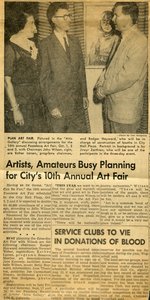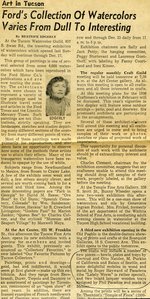Though busy with his contract work, Roger continued painting and drawing, primarily desert landscapes and canyons, and became personally invested in the various happenings of the local Pasadena art scene. Around 1954 he ignited an extended controversy with the Los Angeles County Museum of Art because of his disagreements with their policies for choosing and displaying work in their galleries. In time Roger was essentially barred from presenting his work there, and he became very critical of most judging panels for work in local art shows, convinced that favoritism and conformity with elitist national trends lay at the heart of the non-representational inequality. Roger considered the interaction between artists and the public to be of the utmost importance, and much of his criticism was directed at what he saw as a lack of diverse public involvement in selection processes and exclusion of large swaths of the local art community from public shows. Roger became very active with the Pasadena Artist Associates and for over a decade essentially planned the annual Pasadena Art Fair, a public show put on by the organization to present the works of local area artists of all ages and skill ranges.
In addition, Roger started giving artistically oriented lectures around the area, including some at the Los Angeles Public Library and at various schools. His stock presentation mostly centered on “Styles in Art” and on the scientific and psychophysical aspects of color, an activity that allowed Hayward to fully indulge his interest in color theory.
Hayward also seems to have constructed a chess set out of aluminum and bronze using his father’s old jewelry lathe, appearing with it around 1954 in an LA Times article. This was also a time when the Haywards converted their garage into a “hobbery,” a place where the couple could work together on their own individual projects. Oftentimes Roger or Betty would read to each other, when Betty was working her looms, for example, or when Roger was painting.
In many ways Roger remained intellectually invested in his wartime work for much of the rest of his life, keeping generally abreast of various happenings and developments at the Mt. Wilson Observatory. Many of his post-war hobbies and interests were scientifically connected to his assignments at the observatory, and discussion of his work there came up frequently in his correspondence with several associates. Roger likewise maintained contact with the Operations Research Society of America, an organization that targeted past operations analysts from the Army Air Force and paired them with modern happenings in the fields of their previous work.
The Haywards also established an interesting Thanksgiving tradition around this time with a group of close friends, as well as Duffer, the Haywards’ Boston Terrier, “a gentle, well-behaved little fellow.” They would typically rent a cabin, motel room or accommodations at a ranch near Death Valley or in the Arizona wilderness. There they would enjoy a traditional oversized turkey and take comfort in each other’s company. Daytime typically featured local sightseeing, and at night there tended to be a free-for-all of art, games, reading, cocktails and whatever else people wanted to do. A similar tradition enjoyed by the Haywards and their friends was the flying of kites that was held annually on the weekend after Easter.



